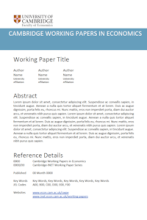This project aims to provide the economic foundations underlying a largely political discussion on the costs and benefits of being the world’s reserve asset/ reserve currency provider. This role has been occupied by the United States at least since the inter-war period and has meant that the dollar has become a barometer of global risk. During periods of global financial distress, international capital systematically flows into dollar assets therefore dollar shortages in foreign markets are an important and recurrent feature of recent financial crises, including as the 2007 GFC and the early-stages of the Covid-19 pandemic. Foreign investors demand dollar debt in large quantities even though, as dollars becomes scarce, the dollar tends to appreciate and the return on a portfolio that is long in dollar bonds, funded by borrowing in foreign currencies becomes significantly negative. Because of the specialness of the dollar, fluctuations in the supply and demand of dollar assets, and the conduct of U.S. policy matter disproportionately in the world economy. Strong and volatile demand for dollars by foreign investors, however, also has stark implications for U.S. domestic outcomes.
In the original proposal, the project promised to “highlight that capital (in)flows to the center country have adverse effects for the center country, particularly when domestic frictions are taken into account, and […] discuss the desirability of macroprudential policies such as capital controls.” I first re-consider the trade-offs faced by the hegemon, as issuer of dollar assets. On the one hand, a scarce dollar leads to a higher return on the net investment position of the U.S.– interpretable as monopoly rents from issuing dollar debt– which results in a transfer from abroad. On the other hand, this transfer leads to an equilibrium appreciation of the dollar which depresses the global demand for U.S. exports, resulting in un- employment and, on impact, results in losses on the portfolio of foreign-currency denominated assets coming due. This setup synthesizes existing results in the literature and captures stylized facts in the data well, all within a tractable framework.
The key contribution, however, is to go a step further. I show that, in the absence of an optimal macro-prudential tax to correct inefficient levels of private sector borrowing, monetary policy alone cannot support the constrained efficient allocation in the hegemon when there are dollar shortages abroad. In other words, the position of the U.S., and in particular the dollar, in international markets, compromises the ability of monetary policy to address domestic incentives. As a result, the hegemon experiences inefficiently volatile output and prices and lower monopoly rents. I then highlight the scope for direct liquidity provision, through the Federal Reserve’s Dollar Swap Line facilities, a widely used policy since the Great Financial Crisis, to be welfare improving for both the hegemon and foreign investors.
I adopt a standard open-economy model, featuring nominal rigidities and financial frictions in international markets. Specifically, dollar and foreign currency markets for financial assets are separate, building on the segmented markets framework of Gabaix and Maggiori (2015). In this framework, dollar assets can be issued by U.S. agents and they can also be manufactured, at an increasing cost, by heterogeneous international financial intermediaries (e.g. non-U.S. banks). Following an increase in the demand for dollar debt by foreign investors because intermediation is costly, the dollar appreciates and the cost of borrowing in dollars fall in equilibrium. More- over, because aggregate intermediation costs are increasing in the size of dollar shortages, the hegemon faces a downward sloping demand for dollar debt. The model is consistent with key recurrent patterns of the dollar around periods of international turmoil when the demand for dollars is high. In particular, the dollar appreciates at the onset of crises and depreciates thereafter. Interest rates on 3-month U.S. treasuries fall, but only moderately. Together, these patterns imply that foreign investors forego significant returns to hold a portfolio of dollar debt which they finance by borrowing in foreign currency during crises. For example, the return on this portfolio in August 2008 was −6% over the next 12 months. Intuitively, foreign currencies which tend to contemporaneously depreciate vis- ́a-vis the dollar in periods of dollar shortages, systematically appreciate thereafter, therefore the dollar cost of repaying foreign debt rises, even if interest rate differentials are small.
The main results of my analysis are as follows. First, I establish that dollar shortages abroad lead to private sector over-borrowing by hegemon households because of two externalities: a financial externality and an aggregate demand externality. The former arises because atomistic households borrowing in financial markets do not internalize that the country as a whole faces a downward sloping demand for dollar debt (the result of frictions faced by financial intermediaries). In other words, atomistic households fail to internalize that issuing an additional unit of dollar debt lowers the price for all other units of debt. Aggregate demand externalities are the result of nominal rigidities in goods markets, preventing the adjustment of prices. Households do not take into account the stimulative effects of their spending on domestic goods on employment. To show that these two externalities result in over-borrowing in the hegemon, I derive that the optimal macro-prudential response to an increase in dollar shortages, at the constrained efficient allocation, is a positive tax on borrowing. I define the constrained efficient allocation as the best feasible allocation that can be supported by the optimal mix of monetary and macro-prudential policy.
Second, I show that when the borrowing tax is not set optimally or is not available, private sector over-borrowing weighs on the trade-offs faced by monetary policy. On the one hand, monetary policy wants to cut interest rates to boost demand for exports and prevent a costly dollar appreciation. However, because of the presence of over-borrowing, monetary policy has an offsetting incentive to raise interest rates and prevent the inefficient (and temporary) boom. Relative to the constrained efficient equilibrium, the equilibrium with monetary policy alone is characterized by excessively volatile output and prices and lower monopoly rents. This result complements the idea put forth by Rey (2015) who argues that countries cannot set monetary policy independently because of a global financial cycle in asset prices driven by the dollar. Following Farhi and Werning (2014), I define monetary policy to be independent if it can achieve the constrained efficient allocation absent the use of any tax on borrowing from abroad. My findings suggest that the U.S. also faces a Mundellian policy dilemma, since monetary policy does not achieve the constrained efficient allocation due to capital flows driven by foreigners’ demand for dollars.
Third, I find that the policy dilemma gives scope for direct dollar liquidity provision in international markets, as exemplified by the Federal Reserve (FED) dollar swap lines, to improve hegemon welfare. Swap lines are agreements according to which the FED lends dollars to a foreign central bank, against good collateral and over short maturities, in exchange for foreign currency. The foreign central bank, in turn, lends dollars to its domestic financial institutions alleviating their dollar constraints. Since the GFC, swap lines have been used extensively. The outstanding dollar swap liabilities amounted to 38% of U.S. GDP in 2008Q4. Like the(missing) macro-prudential borrowing tax, dollar swaps allow the hegemon to address inefficient over- borrowing and stabilize output, but, in stark contrast with the borrowing tax, they achieve these objectives at the cost of eroding monopoly rents as dollar assets become more easily available. As a result, dollar swaps improve outcomes for foreign investors, in contrast to the optimal macro-prudential tax. Since dollar swaps address over-borrowing, they help the hegemon regain monetary policy “independence”. In the baseline model, dollar swaps never improve welfare when the optimal macro-prudential tax is used.
The workings of dollar swap lines in the model are as follows. Financial intermediaries can manufacture dollar debt but are subject to portfolio costs and position limits. Because of this, they are only willing to issue dollar debt if the cost of borrowing in dollars is lower than the cost of borrowing in foreign currency. The tighter the intermediaries’ portfolio constraint, the larger the spread required for the dollar market to clear. By exchanging dollars for foreign currency, dollar swaps increase liquidity in international markets and alleviate the frictions constraining the supply of dollar debt by financial intermediaries. Since smaller dollar shortages moderate the pressure on the dollar to appreciate, swaps contribute to sustaining employment and weaken the incentive for hegemon residents to (over-)borrow. In the case where the only shock in the economy is a one-off dollar demand shock, dollar swaps can, by themselves, fully mute the effects of the shock —but the resulting allocation does not coincide with the constrained optimal. This is because a macro-prudential tax that postpones consumption can simultaneously address over- borrowing and increase the size of monopoly rents transferred from abroad.
Fourth, I highlight that dollar shortages have strong domestic distributional consequences. Given the over-borrowing inefficiency, I consider an extension of the model which distinguishes between households who are financially-active and can trade in dollar debt vis-`a-vis financial intermediaries, and inactive households who consume their current income. Dollar shortages abroad have heterogenous effects one these two types of households. Financially active households benefit from higher returns on their financial position (short in dollar bonds and long in foreign assets) and, unlike inactive households, are partly able to smooth the income loss from depressed exports and from losses on the government’s portfolio of assets. Inactive households lose out even if, in equilibrium, financially active households spend part of the rents they earn on domestic goods, raising domestic income for all residents. The use of dollar swap lines systematically redistributes from financially active to inactive households because they mute the effect of shortages on the exchange rate and erode monopoly rents.
Exchange Rate Risk and Business Cycles
Exchange Rate Risk and Business Cycles, Simon P. Lloyd and Emile A. Marin, Cambridge Working Papers in Economics (2019)
We show that currencies with a steeper yield curve depreciate at business-cycle horizons. We identify a tent-shaped relationship between exchange-rate risk premia (ERRP) and the relative yield curve slope across horizons that peaks at 3-5 years and is robust to a number of controls, including liquidity yields. Within a no-arbitrage framework, ERRP reflect investors' changing return valuations over the business cycle. We calibrate a two-country, two-factor model of interest rates, where exchange rates are driven by business-cycle - transitory and cyclical - risk. The model quantitatively reproduces the tent-shaped relationship, as well as variation in uncovered interest parity coefficients across horizons.


